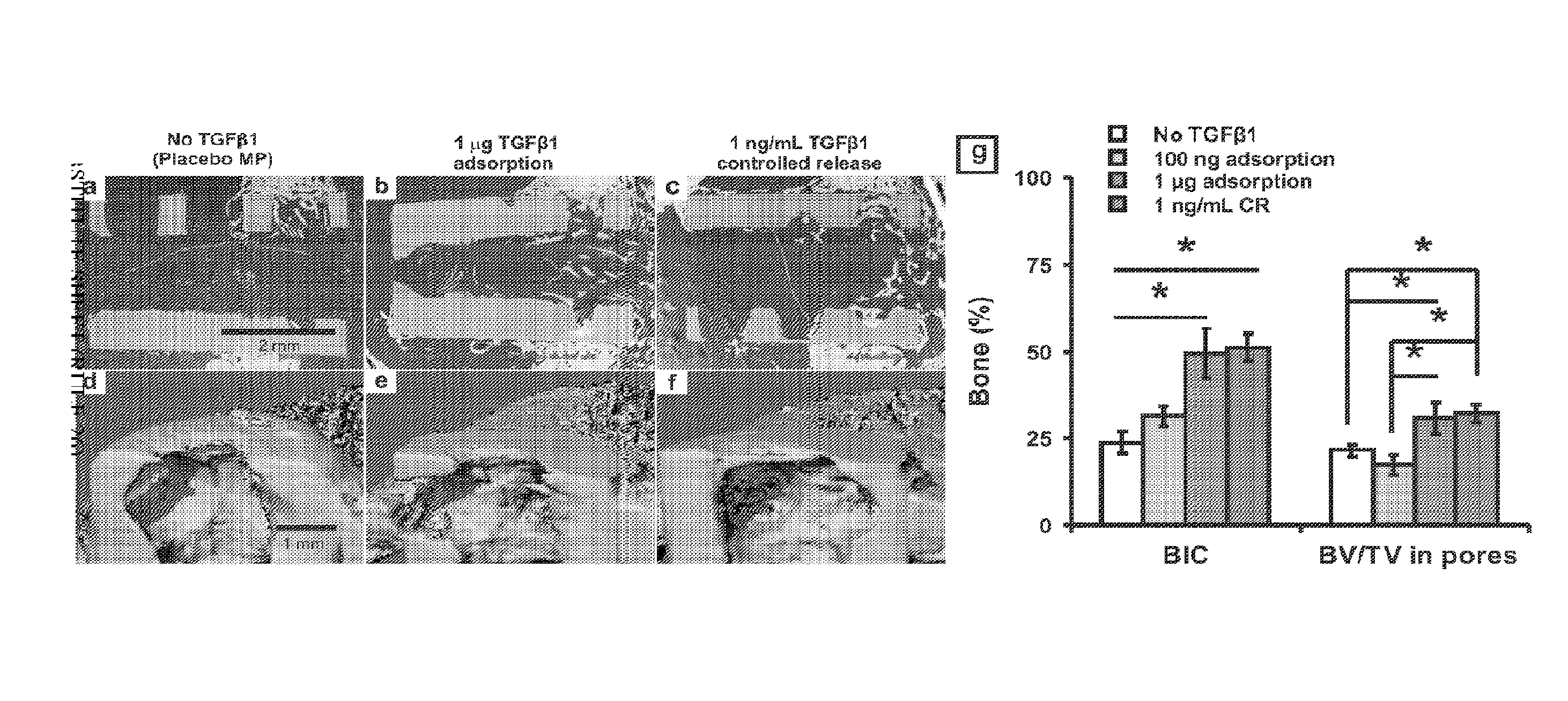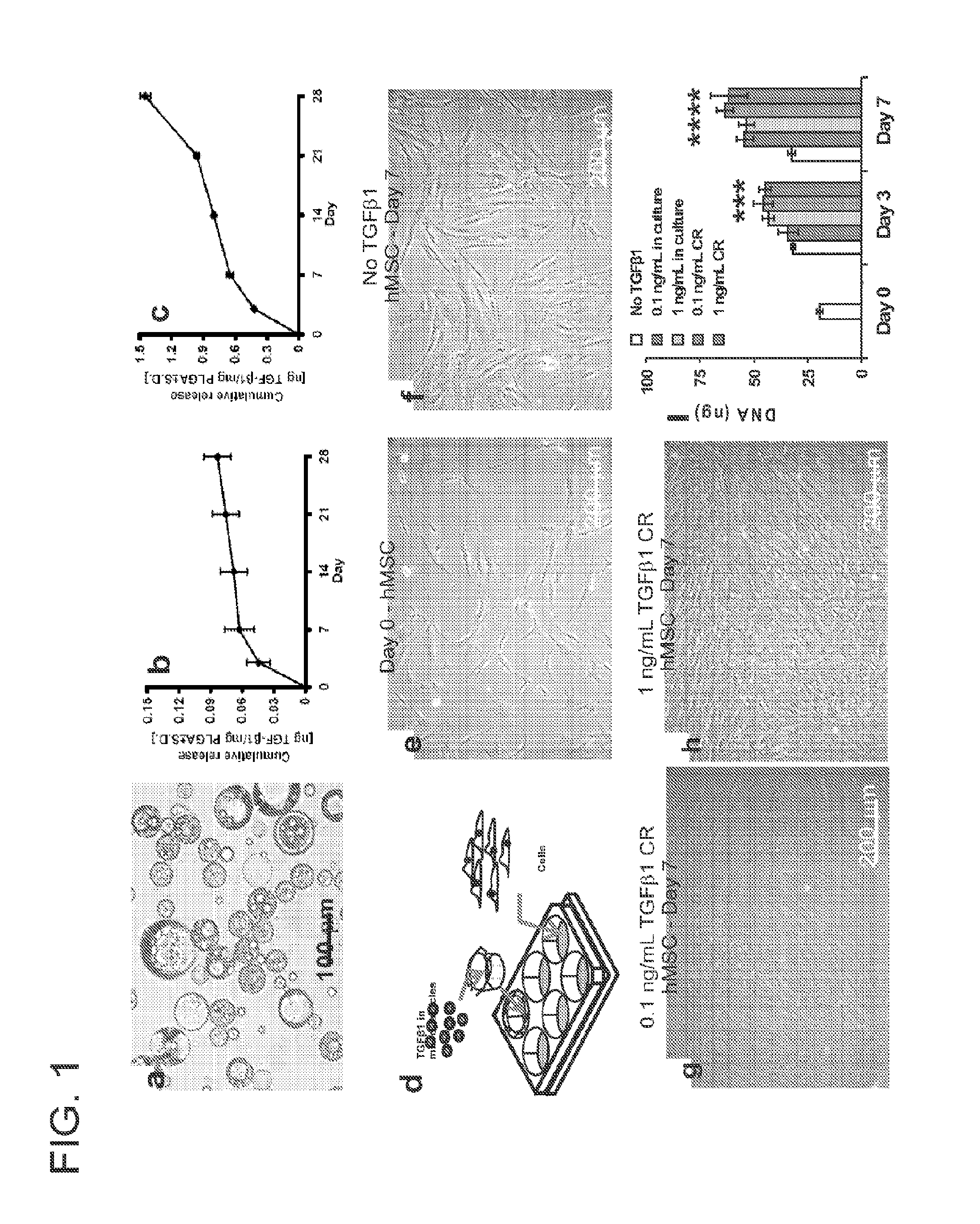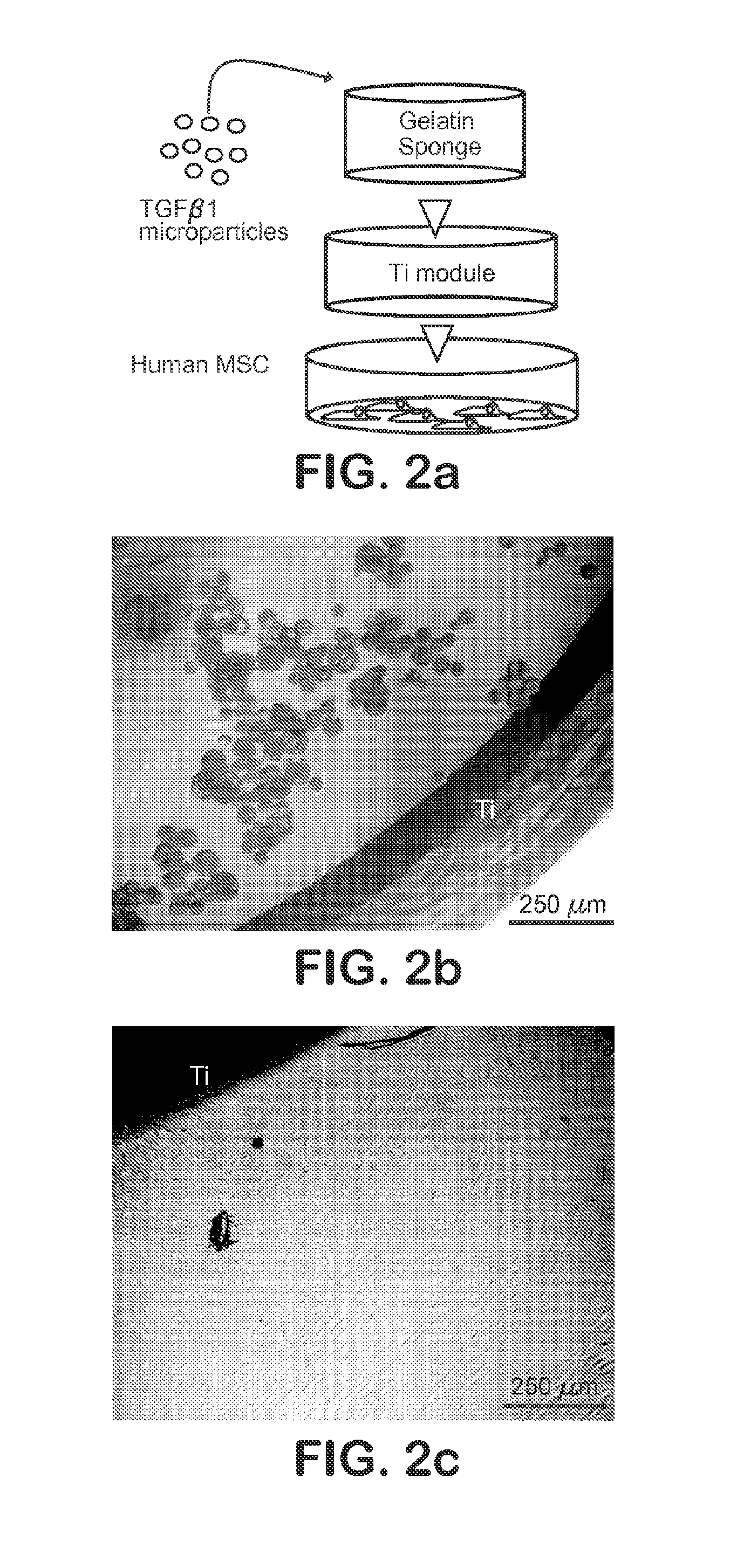Porous implants and stents as controlled release drug delivery carriers
a technology of drug delivery and porous implants, which is applied in the direction of prosthesis, peptide/protein ingredients, and immunodeficiency disorders, etc., can solve the problems of short implant life span, lack of remodeling with host tissue, and many limitations, so as to improve the efficiency of bioactive cue uptake and treatment, the effect of greatly reducing the dosage of bioactive cu
- Summary
- Abstract
- Description
- Claims
- Application Information
AI Technical Summary
Benefits of technology
Problems solved by technology
Method used
Image
Examples
example 1
Dose-Independent Release Kinetics of Microencapsulated TGFβ1
Microencapsulation OF TGFβ1
[0036]Microencapsulation of transforming growth factor β1 (TGFβ1) in poly-lactic-co-glycolic acid (PLGA) (FIG. 1a) was achieved using a double emulsion technique ([water-in-oil]-in-water) (Sumner, D. R., Turner, T. M., Urban, R. M., Virdi, A. S. & Inoue, N. Additive enhancement of implant fixation following combined treatment with rhTGF-beta2 and rhBMP-2 in a canine model. J Bone Joint Surg. Am. 88, 806-817 (2006)). Recombinant human TGFβ1 with a molecular weight of 25 kDa (R&D Systems, Minneapolis, Minn.) was reconstituted in 1% bovine serum albumin (BSA) solution. MPs were observed using a light microscope, with their average diameter measured by fitting circles to match randomly selected microparticles. The MPs were frozen in liquid nitrogen, lyophilized (Sumner, D. R. et al. Enhancement of bone ingrowth by transforming growth factor-beta. J Bone Joint Surg. Am. 77, 1135-1147 (1995)) freeze-dri...
example 2
Controlled-Release Tgfβ1 Induces The Proliferation of Human Mesenchymal Stem Cells in Monolayer Culture
Isolation of Human Mesenchymal Stem Cells
[0040]Fresh bone marrow samples of multiple adult male donors (AllCells, Berkeley, Calif.) were used to isolate MSC. Non-adherent cells were removed by negative selection (Sumner, D. R., Turner, T. M., Urban, R. M., Virdi, A. S. & Inoue, N. Additive enhancement of implant fixation following combined treatment with rhTGF-beta2 and rhBMP-2 in a canine model. J Bone Joint Surg. Am. 88, 806-817 (2006); Moioli, E. K., Hong, L., Guardado, J., Clark, P. A. & Mao, J. J. Sustained release of TGFbeta3 from PLGA microspheres and its effect on early osteogenic differentiation of human mesenchymal stem cells. Tissue Eng. 12, 537-546 (2006)). Adherent cells were layered on a Ficoll-Paque gradient (StemCell Technologies), followed by the removal of the entire layer of enriched cells from Ficoll-Paque interface. The isolated mononuclear and adherent cells w...
example 3
Controlled-Release TGFβ1 From Hollow Titanium Implant is Chemotactic to Human Mesenchymal Stem Cells
Three Dimensional (3D) In Vitro Cell Migration Model
[0043]A gelatin sponge (Gelfoam, Pharmacia, Kalamazoo, Mich.) with pore sizes of 200-500 μm was chosen, given its previously demonstrated support of hMSC growth and wide use in bone regeneration (Cohen, S., Yoshioka, T., Lucarelli, M., Hwang, L. H. and Langer, R. Controlled delivery systems for proteins based on poly(lactic / glycolic acid) microspheres. Pharm. Res. 8, 713-720 (1991)). Scanning electron microscopy (SEM) (Hitachi, S-3000N) confirmed the pore size range of 200-500 μm (FIG. 3b). A hollow Ti implant module (7×6 mm; 1.×dia.) was fabricated and sterilized by autoclave (FIG. 2a). MPs encapsulating TGFβ1 or PBS (placebo control) were infused into the gelatin sponge by negative pressure, which was inserted in the hollow core of the Ti implant (FIG. 2a). The hollow Ti implant was placed in a monolayer of hMSC (FIG. 2a). The foll...
PUM
| Property | Measurement | Unit |
|---|---|---|
| Fraction | aaaaa | aaaaa |
| Fraction | aaaaa | aaaaa |
| Mass | aaaaa | aaaaa |
Abstract
Description
Claims
Application Information
 Login to View More
Login to View More - R&D
- Intellectual Property
- Life Sciences
- Materials
- Tech Scout
- Unparalleled Data Quality
- Higher Quality Content
- 60% Fewer Hallucinations
Browse by: Latest US Patents, China's latest patents, Technical Efficacy Thesaurus, Application Domain, Technology Topic, Popular Technical Reports.
© 2025 PatSnap. All rights reserved.Legal|Privacy policy|Modern Slavery Act Transparency Statement|Sitemap|About US| Contact US: help@patsnap.com



